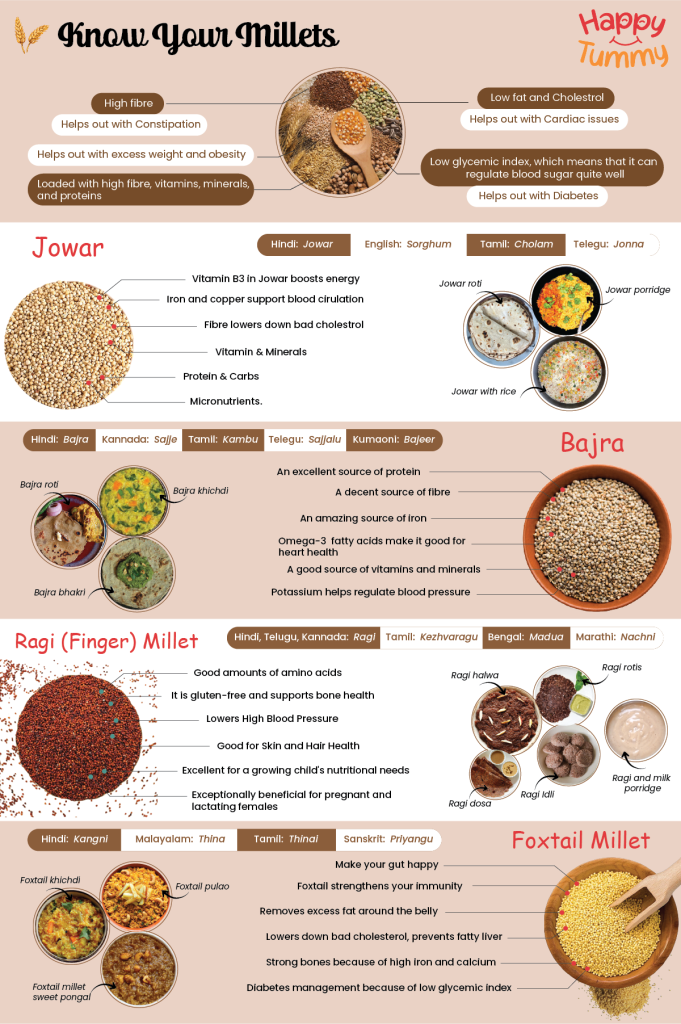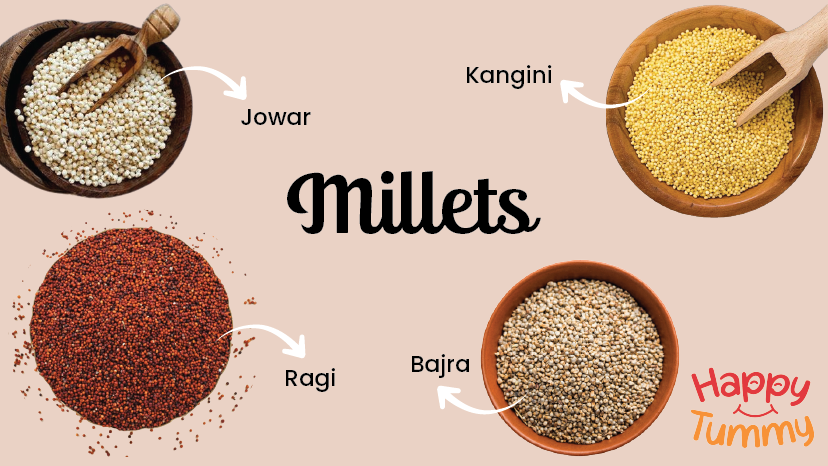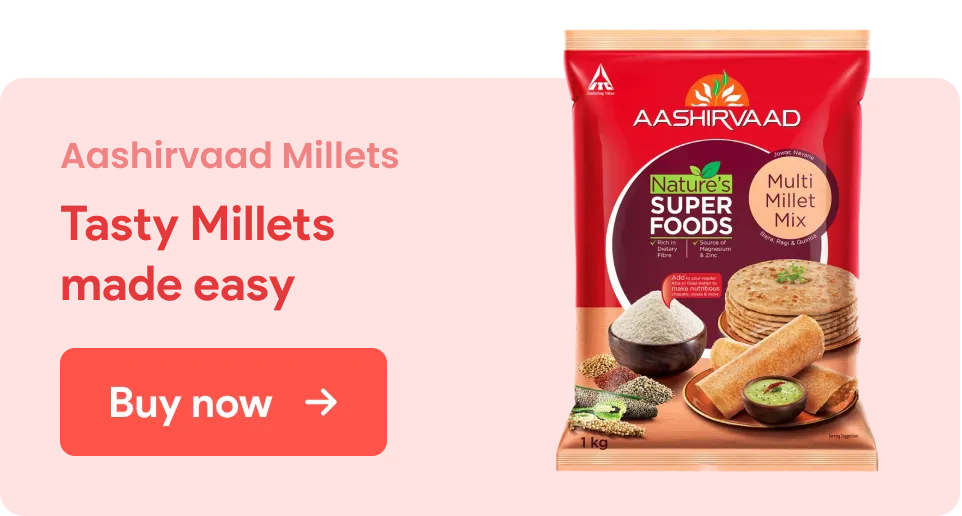Table of Contents
History repeats itself- this idiom holds well in the case of millets. The popularity of coarse grains decreased after the 1960s, but it has been catching up for the last few years. So, Millets have gone through a complete cycle of rise, fall, and rise, which should also pique our curiosity and interest.
I grew up hearing stories of how my grandmother used to cook Bajra roti on chulha, and all children in the house would sit in a queue, waiting for their turn. As my father narrates it too frequently, especially in winter, I can easily see a sense of nostalgia sweeping through his mind and heart.
I am sure all people born in the 1950s or earlier can connect to this feeling of my father because millets used to connect with people of these ages emotionally.
| Millet Name English | Hindi | Telugu (A.P.) | Kannada | Tamil | Marathi | Bengal | Malayalam |
| Sorghum | Jowar | Jonna | Cholam | ||||
| Pearl | Barja | Sajjalu | Sajje | Kambu | |||
| Finger | Ragi | Ragi | Ragi | Kezhvaragu | Nachini | Madua | |
| Foxtail | Kangini | Thinai | Thina |
It is another story that this linking faded away as younger generations moved to wheat and Rice for several reasons that I don’t intend to discuss here. Still, I would like to mention that the demonstration effect, i.e., the perception that expensive is better, played its role in breaking down that connection, those emotions, and the strong thread between food and heart.

Fortunately, we can refresh that connection. Yes, and it is high time to do that….
As U.N. General Assembly has declared 2023 the International Year of Millets, we must recreate the memories our elders have had with coarse grains.
PM Narendra Modi dishing out millet recipes to foreign guests as part of his initiatives to boost millet consumption must trickle down to our interest and enthusiasm – but in a true sense.
It directly means that we, as individuals, should wholeheartedly support national and international initiatives by including millets in our daily diet. Also, there are genuine reasons to do this. Let’s explore some.
Are Millets Super grains? Why?
Yes, coarse grains are superfoods because they are loaded with high fibre, vitamins, minerals, and proteins. On the other hand, they are low in fat and sugar and are free from cholesterol, which makes them ideal for people suffering from diabetes and heart issues.
Some health conditions that you can expect to manage by adding millets to your diet are:
- High cholesterol
- Diabetes (low glycemic index, which means that it can regulate blood sugar quite well)
- Cardiac issues (low fat and cholesterol)
- Constipation (high fibre)
- Excess weight and obesity
Not only this, these crops are sustainable because they can easily endure high temperatures and need low water to thrive. We can see them as future food security in India and a solution to treat malnourishment.
Now, as you know that millets have several nutritional benefits, you also would like to know about specific millets. These are comprehensively explained in further sections.
1. Jowar (Sorghum Millet)
Originated in Africa, Jowar gradually moved to Southern Asia and America. You call it Sorghum in English, Jowar in Hindi, Cholam in Tamil, and Jonna in Telegu. Globally, it is known as the new quinoa for being gluten-free, and, thus, an excellent alternative for people with gluten intolerance.
Additionally, you must consume Jowar because of its high fibre, iron, carbs, protein, vitamin, minerals, and micronutrients. Thus, it can help you with several health issues, like heart problems, obesity, constipation, digestive issues, and diabetes.
The nutritional profile of Jowar entirely suits people suffering from obesity, diabetes, high cholesterol, and sugar. The presence of vitamins C and K makes it suitable for bone health, and Vitamin B supports brain health. Its low glycemic index takes a long time to release glucose into the blood, making it suitable for diabetic people.

Some Easiest Ways to Include Jowar in your Daily Diet
- You can make rotis with multigrain atta (50 percent of wheat with 50 percent of Jowar). It will increase the fibre content, relieving you of digestive issues. You can also make cupcakes with multigrain flour. Additionally, you can use ready-made Aashirvaad’s Multi Millet Mix to nutrify your chapatis without any change in taste. Just add one cup of Multi Millet Mix to three cups of your regular flour or batter, and you are ready to use it!
- You can make porridge by mixing Atta with Jowar, Chana, Sabudana, etc. Cook it to get the desired consistency mixing one part flour and three parts of water. Add jaggery and milk (instead of water) to make sweet porridge.
- If you are fond of South Indian dishes, you can add Jowar with Rice in a 2:1 ratio, i.e., two parts of Jowar to one part of Rice.
Note: These dishes may taste slightly different than usual because Jowar is denser than whole wheat. However, diversifying the choice of food grains will add up to your food’s nutritional quotient. So, it is worth giving it a try!
Enrich Your Festivals with Jowar!
It might also be good to use Jowar in preparing dishes during festivals. Be it modak (a sweet dumpling dish famous in many regions) on Ganesh Chaturthi, Puris on Diwali, Gujiyas on Holis, it will be a novel way to connect with Jowar– wholly, culturally, and religiously. Giving it a try is a must!
2. Bajra (The Pearl Millet)
Known as Bajra in Hindi, Sajje in Kannada, Sajjalu in Telugu, Kambu in Tamil, and Bajeer in Kumaoni, the Pearl Millet is being grown in India since prehistoric times.
Bajra carries a robust association with Indian foods and cultures, a glimpse of which can be found in Rajasthanibajre ki khatti rabdi, Punjabi Bajre ki roti, or Bajre ki Khichdi, Bhakri flatbread famous in Gujarat, Maharashtra, Rajasthan, and Karnataka.
The South Indian State of Tamil Nadu also enjoys a deep association with Kambu in its Porridge Kamban Choru. If you are innovative enough with food, you can think of Bajra dosa or Bajra idlis, or almost anything else that you can cook with wheat.
Now, as you have got to know that Indian cuisines in different states and regions connect well to this millet, it is imperative to know about the motivation behind using it. Here we go explaining it in detail.
What are the Benefits of Eating Bajra?
An excellent source of protein, a decent source of fibre, an amazing source of iron, and a good source of vitamins and minerals, you can reasonably add Bajra to wheat to make multigrain flour and enhance the nutritional value of the rotis or dishes you make with it. Bajra-wheat roti will give you relatively more fibre, more protein, and more iron. On top of that, it is great for people who are intolerant to gluten.
Additionally, if you are a diabetic patient, Bajra can be a good way to include it in your diet regime because of its moderate glycemic index. However, whole Bajra is better than Bajra flour, so you can discuss with the dietician to carry on with the best dietary patterns. It is excellent if you mix Bajra with chana to manage your sugar level.
Bajra is also good if you plan to lose weight because its high fibre nature keeps you full for a longer time, and you don’t feel the craving to eat frequently.
What more do you find in Bajra, and how does it help you?

Things to Consider while Consuming Bajra
- You can consume Bajra in winters; it is not good to eat in summers because it is heat-producing food and makes you feel warmer.
- Bajra releases uric acid; so, people with gout should be cautious.
- If you feel stomach pain and acidity after eating Bajra dishes, you can stop eating it or use it in moderation after discussing it with the dietician.
- Instead of eating whole Bajra roti, you can mix it with other flour like wheat or Rice.
Easiest Ways to Add Bajra to your Diet
- You can either make whole Bajra roti, or mixed Bajra roti by adding Bajra and wheat flour in 30-70 ratio. You can also make rotis using Aashirvaad’s Multi Millet Mix. Adding one cup of Multi Millet Mix to your batter or flour will enhance the nutritional value.
- You can prepare Bajra khichdi by mixing Bajra with Rice in a 70-30 ratio. Soak this mixture for one hour, and cook it in a heavy pan or cooker to get the consistency and softness of khichdi.
- To make bhakri, sift the Bajra flour with salt to taste in a bowl. Knead the dough using lukewarm water, grease it with oil, and leave it for ten minutes. Cook thin rotis with it and eat with butter.
- You can be creative with food choices and use the mixed batter for making idlis, dosas, and other dishes of your choice.
You can mold Bajra or Bajra flour into several dishes to satisfy your taste buds. While there is no doubt about the nutritional value of Bajra, consulting with a dietician is imperative to reap the best benefits!
3. Ragi (The Finger Millet)
I was happy and surprised to see a new dish on the menu card at one of my favourite eating outlets in my city. It was Ragi Dosa, and when I asked, he casually replied, “Yes, people are taking interest in these foods now.”
Finally, it is good that people are becoming aware of millets. Ragi is one of such superfoods, famous in several states in South India. Nowadays, people from other parts of the country have started consuming it, considering its magical health benefits.
Well, the finger millet is known as Ragi in Hindi, Telugu, and Kannada. In Marathi, it is called “Nachni.” People in Bengal know it as “Madua,” and Tamilians call it “Kezhvaragu.”
While the popularity of Rice and Wheat has put Ragi on the backseat like other millets, it cannot deny the ultimate benefits you can derive by adding it to your diet. Let’s talk about what you can expect.
Why You Should Eat Ragi?

It is a rare plant with good amounts of amino acids, thus complementing vegans and vegetarians. Furthermore, it is gluten-free, excellent for a healthy breakfast, supports bone health, and excellent for a growing child’s nutritional needs. Surprisingly, Ragi does not add to the weight of young children but significantly enhances their systematic development.
Also, Ragi is exceptionally beneficial for pregnant and lactating females because of its high content of calcium and iron. Sprouted Ragi grains can help their overall health and hormonal balance.
Few Evidence-based Therapeutic Applications of Ragi

Is Ragi Good for Irritable Bowel Syndrome?
Yes, you can expect good relief from IBS symptoms because Ragi is rich in fibre, which positively influences your bowel movement. However, it is advisable to discuss with your dietician or doctor the quantity of Ragi you should consume every day.
Some Best Ways to Add Ragi to Your Diet
Ragi flour halwa, Ragi and milk porridge, Ragi dosa, Ragi idli, and Ragi-wheat rotis are some easy-to-cook recipes. Additionally, you can use Multi Millet Mixto to add up to the nutritional value of your routine diet.
Does Ragi Have Any Side Effects?
There are no side effects as such, but you should take care of a few things:
- Ragi is prohibited from kidney complications because of its high calcium content.
- Eating Ragi for Breakfast or Lunch instead of Dinner is advisable. High protein content might make it less digestive at night.
4. Foxtail Millet
Ladies and Gentlemen, you might be unaware of Foxtail, but it is the second most widely grown millet after Pearl. We Indians have a special bond with Foxtail, and these tiny nutrition-dense seeds have been mentioned in Tamil’s Sangam Literature. It is known to the people of almost the entire country, but with name variations.
Foxtail is known as Kangni in Hindi, Thina in Malayalam, Thinai in Tamil, and Priyangu in Sanskrit. It is also known as Chinese Millet, Italian Millet, Red Rala, Foxtail Bristle Grass, etc.
Like other millets I have discussed above, Foxtail is a powerhouse of nutrition.
Fibre is ample, Vitamin B-12 is abundant, protein is sufficient for daily requirements, and you can get reasonable amounts of fats and carbs. Besides, richness in iron, calcium, niacin, and thiamine makes it
a must-have food in our daily diet.
If you believe in Ayurveda, Foxtail can balance doshas related to pitta and kapha but can increase vata. Also, it should never be cooked with milk; doing so can crop up severe digestion issues. On the positive side, you have several health benefits which must prompt you to add Foxtail to your daily diet regime.
What are the Health Benefits of Foxtail?
- If you are looking to remove excess fat around the belly, Foxtail can be a good option! Tryptophan, an amino acid, reduces hunger pangs and prevents fatty substances from accumulating in your body.
- You can make your gut happy with Foxtail. It is a fantastic choice because high fibre can relieve constipation, gluten intolerance, and celiac disease.
- Foxtail strengthens your immunity because of the presence of macro and micronutrients. It helps you fight various infections and provides your strength back if you are sick from viral or bacterial infections.

How can You Add Foxtail with Easy Recipes?
- Wash 1 cup of Foxtail millet and soak it in 250 ml water. After 30 minutes, bring it to a boil. Add butter and salt to taste. Cook till it turns soft with the desired consistency. Your healthy Foxtail khichdi is ready!
- You can make Foxtail pulao by substituting Rice with Foxtail. The nutritional value will get enhanced!
- You can also try Foxtail Millet sweet Pongal, and people with diabetes can also eat this in moderation. Cook one cup of Foxtail with a half cup of moong dal in the cooker with 3 cups of water till 4-5 whistles. In another pan, melt the jaggery using a little amount of water. Pour melted jaggery into the cooked millet. Add nuts and eat hot.
Side effects/ Cautions while consuming Foxtail
- Excessive consumption of Foxtail can cause constipation and indigestion.
- If you are pregnant or lactating, it is better to check with the doctor before consuming it.
The Bottom Line…
Now you know much more about millets, their nutritional value, and the reasons for including them in your diet. Though I have shared some simple recipes, it might be challenging for you to mix different flour.
You might need more time to do that or simply not be interested in taking an additional burden to get different flour ground and mix it in the right proportion.
If this is the case, you need not worry! We have made the task easier for you. You can simply add one cup of Aashirvaad Multi Millet Mix to three cups of regular flour or batter, and your flour is ready to provide you with all the richness and the same taste!
Also, it will relieve you of the fear of consuming anything in excess. The Multi Millet Mix contains just the perfect portions of recommended millets!
So, why wait? Simply buy Multi Millet Mix, and look forward to having healthy meals. Happy tummy, happy you, and happy family!
Frequently Asked Questions
Answer: Different millets are rich in different nutrients. You can add them as per your specific requirements. Also, it is better to eat multigrain flour by mixing millet with Rice or wheat.
Answer. You should follow specifications associated with specific millets. For example, Foxtail should never be cooked with milk. It is better to take advice from the dietician to avoid any allergies or side effects. You should strictly check with the doctor if you are pregnant or are allergic to any specific item(s).
Answer. Mixing millet with wheat and Rice is better to enhance the nutritional value. For specific details on how much you should consume, it is always better to check with the dietician.
Answer. Overall, you can expect stronger immunity, healthier digestion, good skin and hair, better bones, and therapeutic benefits.















